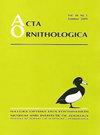波兰异质农田鸟类越冬:丰度和栖息地关联的天气依赖时间变化
IF 1.3
4区 生物学
Q3 ORNITHOLOGY
引用次数: 4
摘要
研究了在波兰西南部马赛克状农业景观中越冬的鸟类群落,以评估鸟类数量和栖息地关联的季节性变化驱动因素。在两个严冬(11 - 3月),采用全面积搜索法对6个样地(共320 ha)的鸟类进行了统计,并将其发生与天气和栖息地联系起来。采用建模方法在群落和物种水平上测试鸟类对环境因素的反应。这些农田居住着各种稠密的越冬鸟类,其中包括相当大比例的保护物种。鸟类数量呈下降趋势,冬季和特定物种的波动尤其受到积雪的影响。种群指数在冬季中期(2月)最低,一直保持到3月中旬。田缘(占总面积的6.6%)支持35.6%的个体和55.0%的畜群。在恶劣天气条件下,对农田边缘生境的偏好比其他农田生境特别突出。我们的研究结果表明,在严冬,复杂的农田是鸟类的重要区域,增强了它们对鸟类繁殖的已知重要性。隆冬时节的强降雪,而不是气温下降,会导致人口立即减少,加剧天然食物枯竭的影响。尽管春季有大批迁徙者涌入,但恶劣的天气使它们的数量一直保持在低水平,直到3月中旬。对冬季条件的行为调整引出了鸟类的特征栖息地分布,暴露了非作物景观元素的至关重要性。特别是,在波兰,农田边缘的多样性极大地促进了国际重要农田鸟类种群的持续存在。本文章由计算机程序翻译,如有差异,请以英文原文为准。
Birds Wintering in Heterogeneous Farmland of Poland: Weather-Dependent Temporal Changes in Abundance and Habitat Associations
Bird communities wintering in the mosaic-like farming landscapes of SW Poland were studied to assess drivers of intra-seasonal changes in numbers and habitat associations of birds. During two severe winters (November–March) the complete area search method was applied to count birds and link their occurrence with weather and habitat in six plots (320 ha in total). A modelling approach was used to test birds' responses to environmental factors at community and species levels. These farmlands were inhabited by diverse and dense populations of wintering birds, including a significant proportion of species of conservation concern. Bird numbers revealed decreasing trends, with winter- and species-specific fluctuations, affected in particular by snow cover. The lowest population indices were recorded in mid-winter (February) and remained low until mid-March. Field margins (6.6% of the total area) supported 35.6% of individuals and 55.0% of flocks. The preference for field margins over other farmland habitats was particularly prominent during severe weather conditions. Our results suggest that during severe winters, complex farmlands are important areas for birds, enhancing their known importance to breeding birds. Intense snowfall in mid-winter rather than temperature drops lead to immediate population declines, aggravating the effects of natural food depletion. Adverse weather keeps populations at low levels until mid-March, despite the influx of spring migrants. Behavioural adjustments to winter conditions elicit the characteristic habitat distribution of birds, exposing the crucial importance of non-cropped landscape elements. In particular, the variety of field margins significantly contributes to the persistence of internationally important populations of farmland birds in Poland.
求助全文
通过发布文献求助,成功后即可免费获取论文全文。
去求助
来源期刊

Acta Ornithologica
生物-鸟类学
CiteScore
2.10
自引率
0.00%
发文量
14
审稿时长
>12 weeks
期刊介绍:
Publishes scientific papers (original research reports, reviews, short notes, etc.) and announcements from all fields of ornithology. All manuscripts are peer-reviewed.
Established in 1933 as Acta Ornithologica Musei Zoologici Polonici, since 1953 continued under the present title.
Published twice a year by the Natura Optima Dux Foundation under the auspices of the Museum and Institute of Zoology, Polish Academy of Sciences.
 求助内容:
求助内容: 应助结果提醒方式:
应助结果提醒方式:


